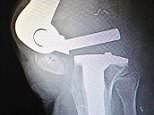This is an image to make anyone who’s had joint replacement surgery wince: the picture shows a new knee that has slipped out of place.
Up to 80,000 total knee replacements are performed each year in the UK. The good news is the surgery has a very high success rate, with 98 per cent of patients returning to their original level of activity, says Haroon Mann, a specialist orthopaedic surgeon at the Royal Free Hospital in London and the Twenty-five Harley Street clinic.
While a new knee will last about 15 to 20 years, as this picture shows, things can go horribly wrong if there’s an accident.
This is an image to make anyone who’s had joint replacement surgery wince: the picture shows a new knee that has slipped out of place
‘It’s likely that the patient had a fall,’ says Mr Mann. ‘It would have been quite a tumble for the joint to slip out like this.
‘You would definitely know if this happened to you. It would be extremely painful and/or the knee would be locked and you would be unable to walk. The patient would have needed surgery to repair or even replace the joint,’ he says.
This image was posted on Figure 1, a website where doctors around the world share medical images and canvass their colleagues’ opinions. In a standard knee replacement, the new joint is comprised of metal and plastic parts, which come in an array of sizes and shapes and may even be bespoke to fit a certain patient.

Up to 80,000 total knee replacements are performed each year in the UK
The replacement joint has stems that are inserted into the thigh and shin bones, with a piece of plastic sandwiched between two metal components for smooth movement.
‘The device here is a more complex prosthesis than the one used in standard knee replacement surgery,’ says Mr Mann.
Known as a hinged prosthesis, it is connected by a hinge held in place with a bolt connecting the two components. It’s the kind of replacement given to someone whose original knee replacement has worn out, or whose bone in the area has been destroyed due to an infection or tumour.
‘This more complex operation is performed in less than 10 per cent of knee replacement cases and only at specialist centres,’ explains Mr Mann.
As with a regular knee replacement, there is a small risk of dislocation if the patient falls over, or because of infection or the loosening of the components, he adds.
‘However, this is rare and you can reduce the risk with exercises to keep the muscles strong and the joint supple.’



